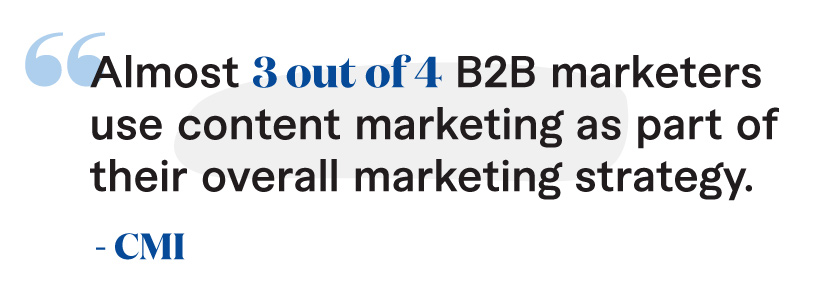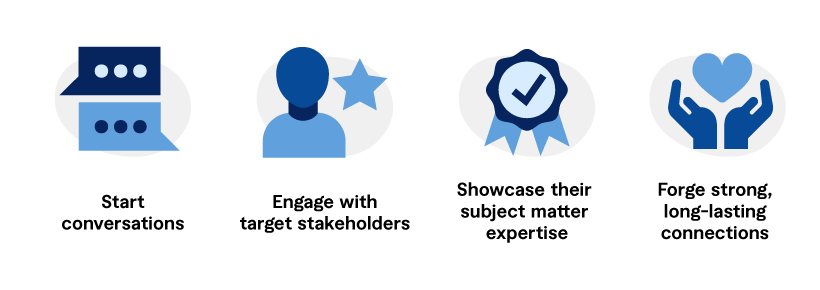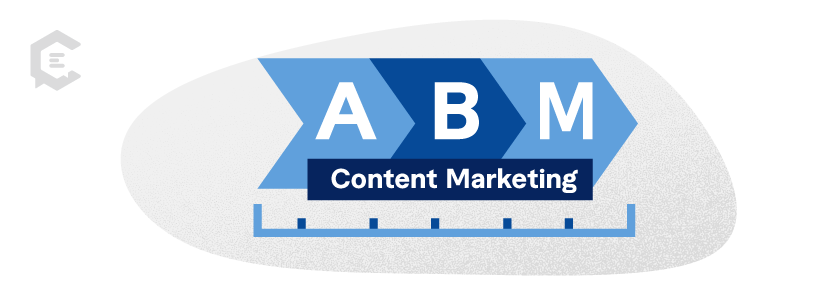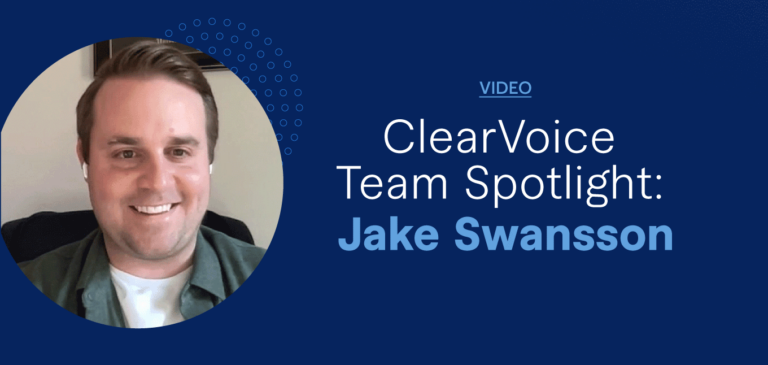Content marketing, in many ways, is like casting a wide net to catch as many fish as possible. You throw many fish back and only keep those you’re looking for. Meanwhile, account-based marketing (ABM) is like fishing with a spear. You don’t catch as many, but each one you catch, you’ll likely keep.
ABM, however, cannot work without a content strategy. Your content — or hook — attracts high-value account targets to your brand, moves them through the sales funnel, and turns them into brand advocates. This makes content marketing an extremely vital component of an effective ABM strategy.
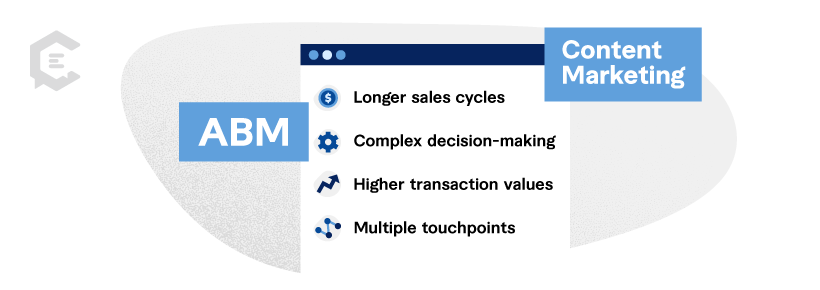
Why ABM and Content Marketing are Better Together
Business-to-business (B2B) marketing is typically characterized by:
- Longer sales cycles: Multiple stakeholders make decisions, and every purchase decision requires thorough evaluation
- Complex decision-making: Because a group makes people’s purchase decisions, marketers must address the concerns of various individuals
- Higher transaction values: Transactions often involve larger sums of money, which is why decisions require higher levels of scrutiny
- Multiple touchpoints: The sales process involves multiple touchpoints, such as networking events, in-person meetings, and online channels. Relationship building occurs over an extended period
Account-based marketing is the practice of identifying and targeting specific high-value accounts and then tailoring your marketing efforts to meet their unique needs. According to a recent ABM Leadership Alliance survey, it’s a key B2B marketing strategy, contributing to 84 percent pipeline growth.
Conversely, content marketing consistently creates and distributes relevant and valuable content to attract and engage a specific target audience. Almost three of four B2B marketers (73 percent) use it as part of their overall marketing strategy, says Content Marketing Institute in their 2022 report.
The ABM sales funnel is made up of these stages:
- Identify: Through research and analysis, identify high-value target accounts that align with your ideal customer profile (ICP)
- Expand: Expand your understanding of target accounts. Map out key stakeholders, determine their pain points, and gather insights to help inform your ABM strategy
- Engage: Create and deliver personalized campaigns and content to connect with key decision-makers and influencers. The goal is to foster engagement across channels and build strong relationships
- Convert: Turn engaged leads into paying customers by addressing any concerns or objections
Without great content that speaks directly to the needs of your target accounts at each stage, your ABM efforts will fall short.
Pairing ABM with Content Marketing: Benefits
Improved target account engagement
By creating content that aligns with the needs of each target account, ABM teams can:
- Start conversations
- Engage with target stakeholders
- Showcase their subject matter expertise
- Forge strong, long-lasting connections
ABM requires not just promotional but also educational content. By consistently providing high-value content, you can position your company as the go-to problem solver in your respective field.
For example, a value-packed financial webinar addressing small business challenges can encourage decision-makers to ask how your finance solutions can help solve their cash flow or funding needs.
Enhanced personalization and relevance
ABM’s goal is to engage each decision-maker. With content marketing, you can create content that speaks to their needs, interests, and challenges. This amplifies the relevance of your campaigns, strengthening the overall impact of your ABM strategy.
Let’s say you provide a marketing automation platform. You can create white paper content tailored to the needs of your target e-commerce accounts. The white paper can include e-commerce automation use cases and success stories that mirror your audience’s pain points and the outcomes they’re looking for in a martech solution.
Increased conversion rates
Personalized, highly targeted content doesn’t only encourage engagement; it also guides prospects through the buyer’s journey. Timely, well-written content answers burning questions and addresses any lingering doubts at various stages of the ABM sales funnel.
For example, an IT-managed services company can create case studies addressing various digital transformation issues. Each study can discuss a specific concern a target account may have at different funnel stages, increasing the likelihood of a conversion.
Strategies for Blending Content Marketing with ABM
Identifying the content needs of your target accounts
To create stellar content that resonates, understanding the content needs of your target accounts is key. This means conducting thorough research and leveraging account insights (discussed in more detail later) to uncover the topics and content formats your audience will respond to.
When researching, go beyond simple demographics. Identify the pain points your target accounts face, the nuances of their industry, and the factors that shape their decision-making processes.
For example, if you’re a cybersecurity company targeting high-value financial services institutions, research:
- The latest cybersecurity threats they’re facing
- The compliance regulations affecting them
- The emerging technologies and trends in the cybersecurity landscape
Creating tailored content
Next, create materials that directly address the challenges and goals of each target account. This can include industry-specific insights, case studies, or even interactive content.
For example, a healthcare technology company targeting hospital networks can create case studies showcasing how their technology enhances patient care, streamlines operations, and ensures compliance with healthcare regulations.
Meanwhile, a technology consulting firm can create an interactive online assessment tool that evaluates target software firms’ IT infrastructures and provides personalized recommendations for improvement.
Multi-channel content distribution
A diversified, multi-channel content distribution approach ensures your messages reach your target accounts where they’re most active.
Say you’re an artificial intelligence (AI) solutions provider targeting a multinational manufacturing corporation. You create a white paper, “AI for Smart Manufacturing,” that explores manufacturing processes and how AI technologies such as machine learning, automation, and predictive analytics can be applied to address manufacturing challenges.
To maximize the white paper’s reach and impact, distribution channels to leverage can include:
- Social media: Craft captivating infographics and social media posts. Share them on LinkedIn, Facebook, and other networks your target account frequents
- Email: Email a direct link to the white paper to key contacts, including the operations manager and chief technology officer (CTO)
- Webinars: Host a webinar discussing the white paper’s findings. Allow for Q&A sessions and interactive discussions
- Industry conferences: Secure a speaking opportunity at a relevant manufacturing industry conference to talk about key findings from the white paper
- Company blog: Create blog posts highlighting the key takeaways
Best Practices for ABM Content Creation
Align content with account insights
Account insights include details about the target account’s business environment, key individuals, evolving challenges, preferences, and priorities:
- Company information: Industry, size, location
- Key decision-makers: Decision-makers, influencers, and key stakeholders — plus their roles and responsibilities
- Business objectives: Short-term and long-term goals, challenges, or pain points they’re currently facing
- Technology stack: Existing tools, software, technologies, and their integration capabilities
- Historical engagements: Previous interactions or transactions between your team and the target account — for example, whether their representatives attended events your company hosted
- Market trends: Trends and developments within their industry, an analysis of the competitive landscape, and their positioning in the market
- Buying behavior: How they make decisions and what factors influence purchasing decisions
- Online and offline presence: Activities and presence on social media, whether they host or join industry events
- Financial health: Analysis of available financial reports to assess their financial health and understand expense and investment patterns
- Regulatory and compliance factors: Specific compliance or regulatory factors that may affect the account
- Recent news and press releases: Recent news, mergers, acquisitions, or any changes within the target account
You can deliver more personalized and impactful messaging by aligning content with the latest account insights.
For example, a logistics optimization company finds out that its target global e-commerce firm plans to expand into new international markets. They develop a content strategy that includes best practice guides on optimizing supply chain logistics for global expansion, which they distribute through webinars, social media posts, and email campaigns.
Produce high-quality content consistently
Your content’s key messaging points should stay consistent with your brand’s values, mission, and objectives. This way, your brand identity remains coherent, making it easier for target accounts to recognize and remember key brand attributes.
Additionally, adopt a rigorous quality control process to ensure high-quality content — including in-depth research, engaging multimedia, and error-free writing. Create a content calendar to ensure a steady flow of content and that your content releases align with key events, product launches, or industry trends.
Measuring the Impact of Account-Based Content Marketing
You can’t improve what you can’t measure, so goes an oft-used marketing mantra. Only by measuring ABM performance can you take the appropriate optimization approach.
Establish key performance indicators (KPIs)
KPIs that make sense align with specific business goals. Some examples:
- Pipeline growth: Track the number of new opportunities generated by your ABM content marketing efforts and the total value of your sales pipeline over time
- ABM program effectiveness: This includes account coverage, the percentage of target accounts your ABM content marketing efforts have successfully reached and engaged, and account penetration, the percentage of accounts where relationships with key decision-makers are building or have been established
- Customer acquisition cost (CAC): Measure the cost of acquiring a new customer per channel to optimize resource allocation (CAC per channel) and the time it takes to recover new customer acquisition costs (CAC payback period)
- Customer retention: Track the percentage of target accounts that continue to engage with your company over time
Analyze content engagement and conversion
Analyzing content engagement and conversion provides valuable insights into the impact of your ABM content.
Content performance
- Determine the average time on site and the number of pageviews to indicate the level of interest and depth of engagement
- Identify which assets resonate well with target accounts and track their performance
- Measure social media engagement through indicators such as shares, likes, and comments
- Track the percentage of readers clicking on calls to action (click-through rate). This indicates whether the content is compelling enough to encourage further interaction
Conversion
- Measure the conversion rates of various content types (blog posts, white papers, case studies, webinars, podcasts, etc.) This determines which topic or format is the most effective at converting visitors into leads or customers
- Track how well your content performs at different stages of the sales funnel
Increase the Effectiveness of Your ABM Approach with Content Marketing
A large part of ABM’s success hinges on content personalization. With a well-planned content strategy, you can transform generic outreach into a tailored conversation with high-value accounts. To learn more about how ClearVoice can help, connect with an expert content strategist.
